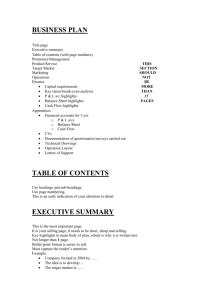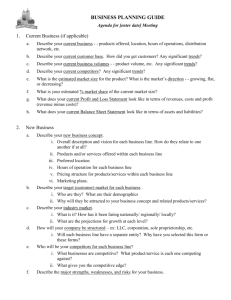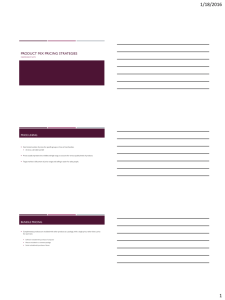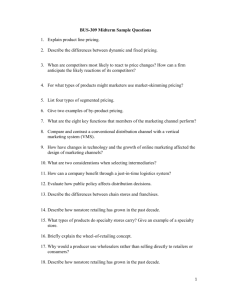Business Plan 2 (WORD version)
advertisement
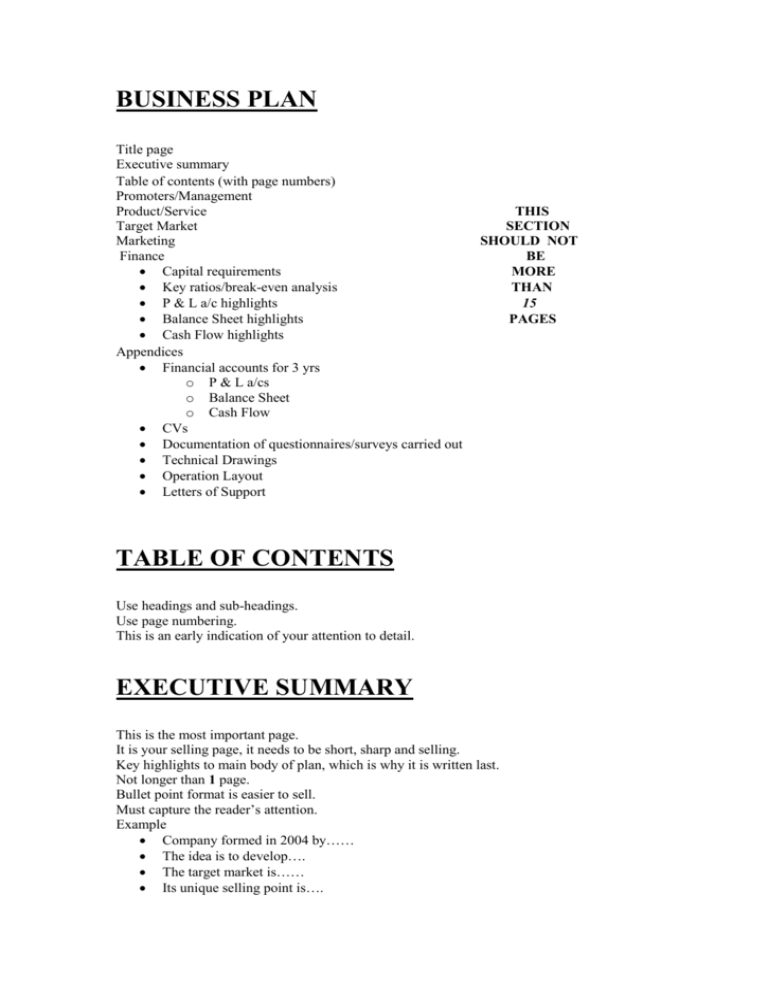
BUSINESS PLAN Title page Executive summary Table of contents (with page numbers) Promoters/Management Product/Service Target Market Marketing Finance Capital requirements Key ratios/break-even analysis P & L a/c highlights Balance Sheet highlights Cash Flow highlights Appendices Financial accounts for 3 yrs o P & L a/cs o Balance Sheet o Cash Flow CVs Documentation of questionnaires/surveys carried out Technical Drawings Operation Layout Letters of Support THIS SECTION SHOULD NOT BE MORE THAN 15 PAGES TABLE OF CONTENTS Use headings and sub-headings. Use page numbering. This is an early indication of your attention to detail. EXECUTIVE SUMMARY This is the most important page. It is your selling page, it needs to be short, sharp and selling. Key highlights to main body of plan, which is why it is written last. Not longer than 1 page. Bullet point format is easier to sell. Must capture the reader’s attention. Example Company formed in 2004 by…… The idea is to develop…. The target market is…… Its unique selling point is…. The key benefits are…… The size of the market is now….and has increased by….. The main competitors are…… PROMOTERS/MANAGEMENT Introduction. Background to business idea. Mission Statement (what is the purpose of the company). Business Objectives. Founders (relevant experience, CVs – put in appendix) Ownership. Legal structure. Organisation structure. Key personnel. Roles and responsibilities. Number of staff required. Key advisors. SWOT analysis (Strengths, Weaknesses, Opportunities and Threats) – have a lead-in and comment afterwards. For example, highlight weaknesses but state how these will be improved. PRODUCT/SERVICE Core Product/Service (describe in detail) Functions (including secondary or other potential uses) Features Design (any technical details can be included in appendices) Colours, sizes, different models etc Packaging How easily can the product/service be copies by competitors Intellectual Property (licensing, trade marks, copyrights, patents, registered designs,) Services Sales service After sales service Delivery Availability Advice Finance provided Guarantees/warranties Add-ons Benefits to the customer Product/Service Development and Innovation Future Product/Service Range/Markets What can be further done to improve the business TARGET MARKET Market information (you must have statistics and sources) Size of market Market structure Recent trends Market potential Key environments factors (PEST) o Political o Economical o Social o Technological Profile key competitors (including substitute products) Strengths/weaknesses Unique selling point Turnover Market share Employees Pricing Profile different market segments Detail your market research (in essence market research should be looked at as ‘gathering information’) Who did you research Methodology (where, when, how, total number of people researched) Analysis (give figures, tables, diagrams – appendices for more detailed information) Profile target market (particularly first customers) What is your UNIQUE Selling Point (USP)? MARKETING Pricing Pricing strategy Cost leader Mark up pricing Target return pricing Perceived value pricing – value pricing Going rate pricing Sealed bid pricing Psychological pricing Promotional pricing Cost plus margins Discounts Payment terms Gross and net margins Margins to people in the distribution chain Fixed, variable and semi-variable cost Distribution Typical channels for this product/service Organisational resources Geographical coverage Where does the customer want to purchase? Different options? Number of outlets Channel intermediaries (give details/statistics) Agent Distributor Wholesaler Retailer Physical distribution Packaging Stock-holding Transportation Competitors’ strategies Promotion Brochures, literature, websites Publicity Advertising Promotions Direct marketing One-to-one selling Telemarketing/internet Trade fairs/exhibitions TV Radio Newspapers Magazines Directories/yearbooks Cinema Outdoor media Sales Tactics Own sales force Other sales personnel Direct personnel Internet Agents FINANCE Capital requirements Founders equity Investor equity Debt finance Grant aid Key ratios / sensitivity analysis Expected Gross and Operating Margins Profit potential Fixed, variable, semi variable costs Months to breakeven Months to positive cash flow P&L a/c highlights Balance Sheet highlights Cash flow highlights Investors How much money do you want? What equity stake/ownership are you offering me? What is the expected return on investment? When do I get my money back? How do I get my money back (exit strategy)? Lenders What security are you offering? What risk is involved for the lender? How good is your ability to repay the loan? What is the schedule of payments? What owners’ equity is being put into the business? What is the credit history of the owners? APPENDICES Finance accounts (3 years) P&L a/cs Balance Sheet Cash flow CVs Technical drawings Operation layout Letter of support Transcript of questionnaires or research taken Any addition relevant information
